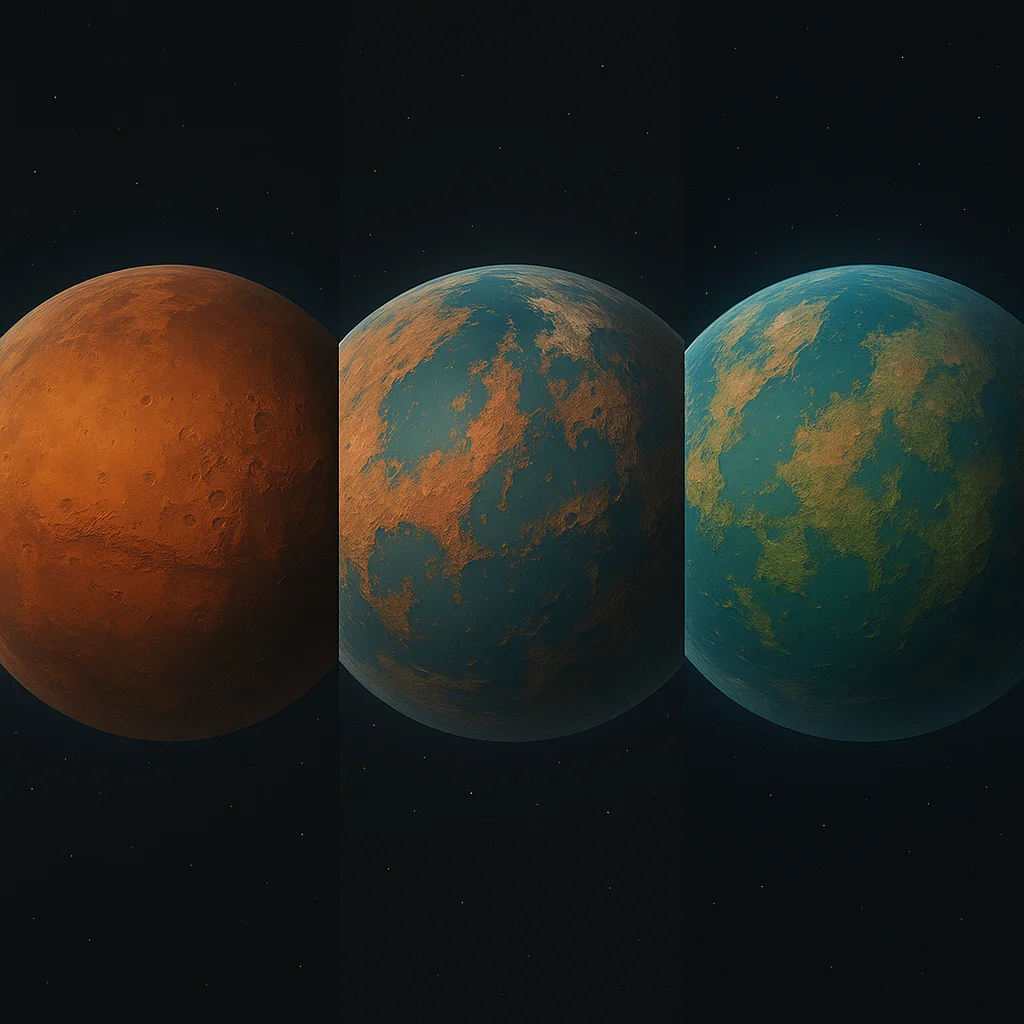Terraforming represents the ultimate expression of human ambition: the transformation of entire worlds to support life. Once purely the domain of science fiction, serious scientists now debate not if we can terraform other planets, but when and how we should begin.

What Is Terraforming?
Terraforming—literally "Earth-shaping"—is the theoretical process of modifying a planet's atmosphere, temperature, surface topography, and ecology to make it habitable for Earth-based life. It's planetary engineering on the grandest scale imaginable.
The concept requires mastery of:
- Atmospheric Engineering: Creating or modifying a breathable atmosphere
- Climate Control: Regulating planetary temperature through greenhouse effects
- Hydrological Systems: Establishing stable water cycles
- Magnetic Field Generation: Protecting against solar radiation
- Ecological Introduction: Creating self-sustaining biospheres
Prime Candidates for Terraforming
Mars: The Frozen Desert
Mars stands as humanity's most likely first attempt at terraforming. Despite its current harsh conditions, the Red Planet possesses several advantages:
- Water Ice: Massive deposits at the poles and underground
- CO₂ Atmosphere: Thin but present, locked in polar caps and soil
- Day Length: Nearly identical to Earth's
- Raw Materials: All elements necessary for life exist on Mars
The terraforming process for Mars might involve:
- Releasing CO₂ from polar caps using orbital mirrors or nuclear detonations
- Importing ammonia or methane from outer solar system bodies
- Creating factories to produce super-greenhouse gases like CFCs
- Melting subsurface ice to create oceans and water vapor
- Eventually introducing extremophile organisms to begin oxygen production
"Terraforming Mars is not a question of technology—it's a question of will and time. We have the knowledge; we need the commitment to a multi-generational project." — Chris McKay, NASA Planetary Scientist
Venus: The Hellish Twin
Venus presents the opposite challenge—too much atmosphere rather than too little. With surface temperatures hot enough to melt lead and crushing atmospheric pressure, Venus requires cooling and atmospheric reduction:
- Solar Shades: Massive orbital sunshades to reduce incoming solar energy
- Atmospheric Processing: Converting CO₂ to oxygen and carbon
- Hydrogen Import: Bringing hydrogen from gas giants to create water
- Rotation Acceleration: Venus's 243-day rotation would need modification

Interestingly, Venus's upper atmosphere at 50-60km altitude already has Earth-like temperatures and pressures, suggesting floating cities could precede surface terraforming.
Titan: The Methane Moon
Saturn's moon Titan offers unique possibilities with its thick nitrogen atmosphere and hydrocarbon lakes:
- Already has atmospheric pressure 1.5 times Earth's
- Protected by Saturn's magnetosphere
- Rich in organic compounds
- Would require significant warming and oxygen introduction
Terraforming Technologies
Atmospheric Processors
Massive industrial facilities would convert existing atmospheres, breaking down CO₂ into oxygen and carbon, or synthesizing new atmospheric components. These planet-scale factories would dwarf any human construction ever attempted.
Orbital Mirrors and Shades
Controlling a planet's temperature requires managing incoming solar radiation. Vast mirrors could warm Mars by concentrating sunlight, while equally massive shades could cool Venus. These megastructures would likely be constructed from asteroid materials.
Biological Engineering
Genetically modified organisms could accelerate terraforming:
- Extremophiles: Bacteria that thrive in harsh conditions could begin atmospheric conversion
- Engineered Algae: Rapidly producing oxygen while consuming CO₂
- Synthetic Biology: Custom organisms designed for specific planetary conditions
Magnetic Field Generation
Mars lacks a global magnetic field, leaving it vulnerable to solar radiation. Proposed solutions include:
- Orbital magnetic shield satellites at Mars-Sun L1 point
- Superconducting rings around the planet
- Restarting the planetary dynamo (highly speculative)
Timescales and Stages
Terraforming is not a quick process. Even with advanced technology, transforming a planet would take centuries to millennia:
Stage 1: Warming/Cooling (50-100 years)
Initial atmospheric thickening or thinning, temperature adjustment through greenhouse gas management or solar radiation control.
Stage 2: Atmospheric Conversion (200-500 years)
Converting the atmosphere to include oxygen, managing pressure, establishing basic water cycles.
Stage 3: Hydrosphere Development (500-1000 years)
Creating stable oceans, rivers, and precipitation patterns. Establishing ice caps and seasonal variations.
Stage 4: Biosphere Introduction (1000+ years)
Introducing progressively complex life forms, from bacteria to plants to animals, creating self-sustaining ecosystems.

Ethical Considerations
Terraforming raises profound ethical questions:
Planetary Protection
If microbial life exists on Mars or Venus, do we have the right to transform their worlds? The discovery of even extinct life would complicate terraforming ethics.
Environmental Philosophy
Should we preserve planets in their natural state, or is transformation justified for species survival? This debate echoes Earth's environmental movements on a cosmic scale.
Resource Allocation
The resources required for terraforming could address many of Earth's problems. Is it ethical to pursue off-world projects while our home planet faces climate crisis?
Governance
Who decides whether to terraform a planet? What political structures would govern a multi-generational, species-wide project?
Paraterraforming: A Compromise
Rather than transforming entire planets, paraterraforming involves creating enclosed habitable spaces:
- Worldhouses: Planet-spanning transparent roofs containing breathable atmospheres
- Crater Domes: Covering individual craters with pressurized habitats
- Underground Cities: Vast pressurized cavern systems
These approaches could provide living space much sooner than full terraforming while preserving planetary environments.
The Far Future: Designer Worlds
Advanced civilizations might go beyond recreating Earth conditions to designing custom environments:
- Low-gravity worlds for specific industries or sports
- High-pressure oceans for aquatic adaptations
- Exotic atmosphere compositions for unique ecosystems
- Binary planet systems with shared atmospheres
Beginning the Journey
While full terraforming remains centuries away, the journey begins now. Every Mars rover analyzing soil composition, every closed-loop life support system on the ISS, every genetic modification to help plants survive harsh conditions—these are the first steps toward reshaping worlds.
Terraforming represents humanity's graduation from a single-planet species to true cosmic gardeners, spreading life throughout the galaxy. It's a vision that spans generations, requiring unprecedented cooperation and commitment. But if successful, we won't just have survived as a species—we'll have given life itself new worlds to call home.
The planets await our touch. The question is not whether we can transform them, but whether we're ready for the responsibility of becoming creators of worlds.